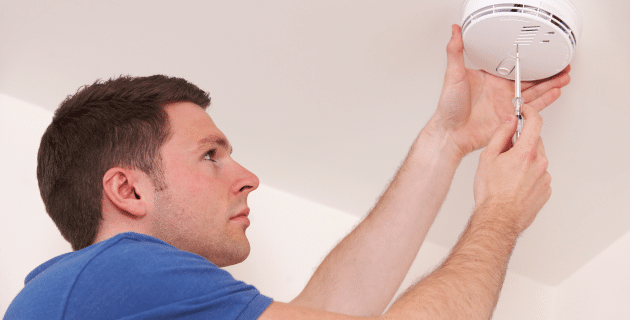If you’ve ever accidentally set off the smoke alarm, you know how loud it can be. But that loud beeping is actually a good thing. Smoke detectors give us that important warning to get safely away in case of a fire. Some detectors do double duty and also alert to carbon monoxide.
However, don’t assume your smoke detectors are working if you’ve installed them once and then never touched them again. Batteries wear out, and detectors have a lifespan of only about 10 years. That’s why it’s important to test yours regularly and there is no better time than when you are spring cleaning.
Two types of detectors
You may have a battery-powered smoke detector or yours may be hard-wired. They look the same from the outside but they’re a little different.
-
- The battery-powered detector snaps into a plastic base that is screwed onto the ceiling or wall. In many newer models, batteries are non-removable and come with a 10-year warranty.
Follow these steps
Both types of smoke detectors have a test button that allows you to check if they are working. Test your smoke detectors at least twice a year, once in the spring and once in the fall, and replace them as needed.
Step 1: Let family members know you’ll be testing.
A smoke alarm could cause family members to think there is a real emergency, so let them know that you are going to run a test. Since the sound could frighten small children and pets, you may want to test while they are not around. In addition, if your smoke detector is connected to an alarm company, notify them or you could have the fire department show up at your door.
Step 2: Position someone away from the detector.
Ask a family member or friend to stand on another level of the house, to make sure the alarm is heard. You want to make sure that the warning is heard downstairs in the basement and upstairs, in case someone might be there when it sounds.
Step 3: Press and hold the test button.
You may need to stand on a chair or a ladder to reach the button on your detector. You can use a broom handle if you are able to reach it that way. Note that it may take a few seconds to start. You will hear a loud siren. If there is no sound or a weak one, the batteries and/or the detector need replacement. Make sure to repeat this test with every smoke detector in the house or apartment.
Pro Tip: Some smoke detectors can go into programming mode if you hold the button too long. Wait for the detector to return to normal before testing it.
Step 4: Try this way to check your detector’s sensor.
The test button checks that your detector is powered. However, it doesn’t check the smoke sensor. You can do so with an aerosol spray that you can purchase for a few dollars at a hardware store. Follow the directions on the can to spray the “smoke.” This is a safer way to check the sensor than lighting matches. After the test, you can use a handheld vacuum to remove the material from the detector.
Pro Tip: Some detectors have a button to push to stop the alarm. Find out if yours has one before you run this test.
Other important tips
-
- If you have a detector where you have to change the batteries, you should replace them twice a year. (When we change the clocks is a great time to do that.) If your smoke detector is older than 10 years, you should replace it even if it is working.
-
- Dust and dirt build-up can affect your detector. Keep your detectors clean.
-
- Don’t paint your detector to match your décor. That can interfere with their ability to detect smoke.
-
- Make sure you have enough detectors in your home or apartment. You should have one in your kitchen, but 10 feet away from cooking to avoid false alarms. You also will want to place them inside every bedroom and outside each sleeping area, on every level of your home, and in places where you keep flammable substances like the garage.
You want to be fully prepared in case of a fire, and not just with smoke detectors. Talk with your insurer about your home and property to ensure that you are fully covered.
This article is furnished by California Casualty, providing auto and home insurance to educators, law enforcement officers, firefighters, and nurses. Get a quote at 1.866.704.8614 or www.calcas.com.
- Graduation – When to Remove Your Child from Your Auto Policy - May 18, 2023
- How to Prevent Catalytic Converter Theft - May 17, 2023
- How Much Does Home Insurance Cost? - May 17, 2023

